During the night we were woken from our fitful, sticky sleep by the slight patter of rain on the roof! Seconds later we were outside in our night clothes hoping for a thorough soaking. Alas, after a few sputters the rain departed leaving us with nothing but a few ineffectual rolls of thunder. This morning all evidence of the rain had disappeared and the sun rose as hot and bright as ever.
We left the campsite as quickly as possible, having not a speck of shade around Modestine, and returned to the little town of Husum. Acting on local advice, at the railway station we discovered everything we needed - an air conditioned café with a really effective and cheap internet connection plus large mugs of good filter coffee and croissants that tasted every bit as good as those in Paris. From then on things seem to have gone so much better for us. With the cooler temperature we felt well and comfortable again for the first time in ages and the internet worked like a dream for us. We found ourselves smiling again and starting to make plans. Outside in the streets it was as airless as before but we hugged the shadow of the walls as we passed through the streets of this attractive little Friesian town. Ian wanted to visit the home of the local writer Theodor Storm as he had studied and enjoyed his writings at University. Jill had never heard of the writer but was more than happy to explore the interior of one of the lovely early 19th century houses. Ian found great pleasure in reading various letters and manuscripts displayed in the house by the Theodor Storm Society, and we both enjoyed seeing the rooms, much as they would have been in the 1860s, with the writer's own furnishings, photos and artefacts. Despite the large rooms and high ceilings, the air was stifling inside and the curator told us the weather here has been like this for weeks with the few drops of rain last night being the first for ages.
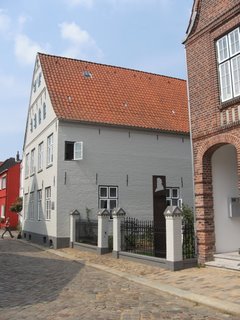 Theodor Storm's house, Husum
Theodor Storm's house, Husum Garden, Theodor Storm's house, Husum
Garden, Theodor Storm's house, Husum Interior, Theodor Storm's house, Husum
Interior, Theodor Storm's house, Husum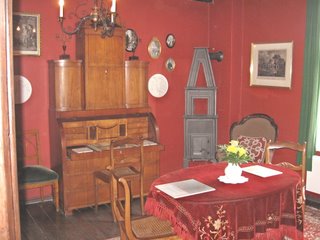 Theodor Storm's study, Husum
Theodor Storm's study, Husum Interior, Theodor Storm's house, Husum
Interior, Theodor Storm's house, Husum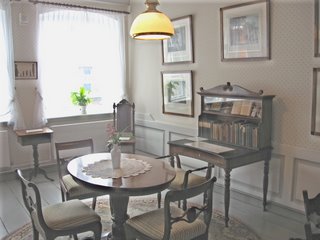 Interior, Theodor Storm's house, Husum
Interior, Theodor Storm's house, HusumWe looked briefly at the harbour and walked up to the pretty little castle set in shady parkland where Ian had vainly hoped to find some exhibits from the North Friesland museum which is currently closed for restoration. Back in the town we discovered a store with air conditioning and spent far longer than we needed choosing a map and guide book in German to Denmark.
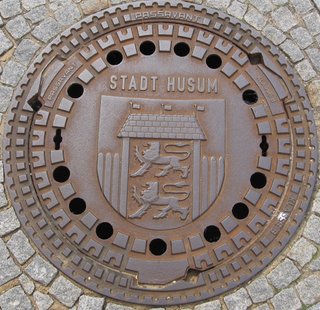 Manhole cover, Husum
Manhole cover, Husum Street organ grinder, Husum
Street organ grinder, Husum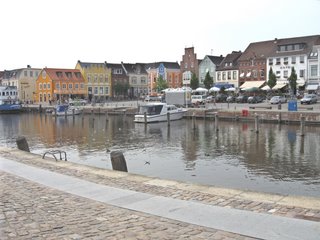 Harbour, Husum
Harbour, Husum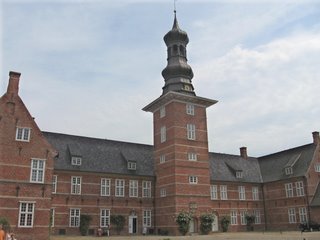 Castle, Husum
Castle, Husum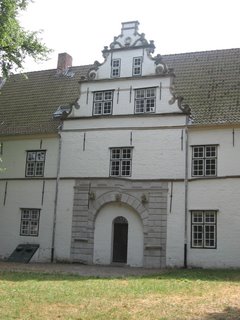 Castle gatehouse, Husum
Castle gatehouse, HusumThere seems to have been considerable subsidence during construction to judge by the alignment of the portico
We left Husum around 3pm and drove north by minor roads that enabled us to explore the polderlands, tiny villages, isolated farmsteads, dykes, canals, small sluices and drainage works, sheep, cabbages and wheat. Climbing up on top of one of the dykes we could see where gradually the mudflats were being reclaimed, silt building up behind low hurdles and little by little being drained and eventually planted with tough grass on which sheep seemed happy to browse. The open sea was invisible, far away across miles of shallow, oozing grey mud and reed beds.
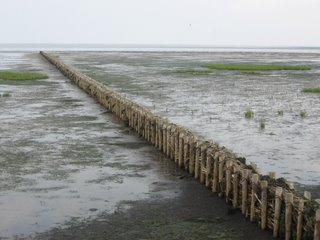 Hurdles used to assist in land reclamation, North Friesland
Hurdles used to assist in land reclamation, North Friesland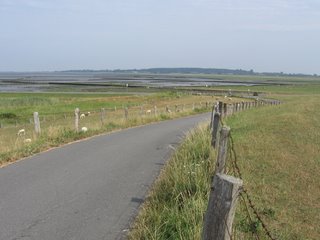 Typical landscape, North Friesland
Typical landscape, North Friesland View down onto thatched cottages from the top of a dyke near Wobbenbüll
View down onto thatched cottages from the top of a dyke near WobbenbüllThe land all along this coast has been reclaimed from the sea and a high dykes hide it from view, protecting those inside. There is a saying here that while God created the sea, the Frisians created the coastline. This is undeniable. How long they will manage to hold it against the sea is questionable. Little by little the sea is winning, as shown by comparing some of the older maps with those of today.
Eventually we arrived here at Dagebüll on the west coast. Apart from being a very agreeable tiny North Sea bathing resort, it is the port from where the ferries leave taking passengers and vehicles regularly out to the islands of Föhr and Amrum. Further out to sea, completely isolated, lies Helgoland.
A cool breeze greeted us that made the sun bearable. After sorting ourselves out on a very pleasant little campsite we took Hinge and Bracket and cycled off to explore the area. It has been a wonderfully pleasant evening. The sun has clouded over and the breeze ensures we no longer feel permanently sticky from the heat. On the other hand, the air is so damp and charged with salt that we feel just as sticky but many degrees cooler. Here we are really at the sea. It breaks in waves against the shore lined with beach huts and a cycle track on the seaward side of the grassy dyke. We watched the ferry returning from Föhr as we paddled in the North Sea, though it felt warm enough to be the Mediterranean. On the horizon we could see several of the surrounding islands.
Ian had been here as a child and remembered a special train that made its way along a narrow track and across a causeway out to the Hallige (small islands) of Oland and Langeness. Its timetable was regulated by the tides and the wind as it was driven by a sail. We cycled along the path beside the sea and eventually found the rather overgrown railway track stretching out across the mud flats grazed by sheep, with reeds and marsh birds including a huge heron and an orange-billed black and white oyster catcher. The area is now a nature reserve for seabirds and seals.
 Track for the sail-driven railway out to the islands, Dagebüll
Track for the sail-driven railway out to the islands, Dagebüll Enthusiasts working on the train, Dagebüll
Enthusiasts working on the train, DagebüllTurning back inland we sought out the engine shed for the train and discovered it being worked on by a couple of railway enthusiasts who were happy to show us the tiny trucks with the mast attachment for the sail. One of them even remembered Tante Magda, the lady who used to sail the train along the track during the days that Ian spent here. Apparently she was quite a local character. Sadly for us the trains do not run very often to the islands which are now nature reserves and when they do it largely to supply the Hallige and for coastal protection work.
So we went to the ferry port to discover if we could take Hinge and Bracket out to Föhr for the day. This looks a lot more promising so depending on the weather we may do that tomorrow. A slight problem is that we should find a garage as we have discovered one of Modestine's tail lights has broken.
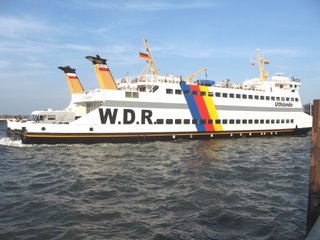 Ferry leaving for Föhr, Dagebüll
Ferry leaving for Föhr, DagebüllIt was pure joy to sit outside Modestine for supper this evening. The sun had disappeared, leaving a slight pink glow over the sea, and there was a cool breeze. Our skin was sticky with salt and eventually we were actually obliged to put on our pullovers! It seems inconceivable after the heat of this morning! Our energy is fast returning.
A final delight came when we discovered we are now able to pick up the BBC on our radio! It will again be possible for Jill to follow the events in Ambridge, once she can unravel the complex shenanigans that appear to have been taking place in this rural idyll over the past year. We will also be able to hear the news again. Both programmes will probably be much as they were this time last year. Disasters in Iraq and the Middle East, droughts in South East England and corruption in the Labour party. Emma Grundy giving Will and Eddy the run around, Alisdair and Shula at loggerheads and yet another Country and Western event organised by Jolene and Fallan at the Bull. Are we right?
Saturday 29th July 2006, Dagebüll, on the North Sea, Schleswig-Holstein
No two days are ever the same and almost every day turns out to have some unexpected twist to it. We have not been to the island of Föhr today after all. This morning was almost chilly, a perfect day for cycling around on a treeless flat island but we decided we'd better drive into Niebüll, the nearest little town and the last of any size before reaching Denmark. Tomorrow being Sunday we realised we would be unlikely to find a garage where we could get Modestine's lights sorted. So by 9.30 this morning we were already in Niebüll, a town of about 9,000 inhabitants. Here we were directed to the Mercedes garage which had a workshop open this morning. In no time the repair was made, curiosity expressed about Modestine being a right-hand drive and they even checked our tyre pressures for us. When we went to pay, the bill for 30 minutes work and a couple of bulbs was 4 euros! They couldn't be bothered to charge for labour or writing official receipts so just charged us for the bulbs! We do not imagine any Mercedes main dealer would do that in England, particularly for working on a vehicle with which they were not familiar.
There was a market in the centre of Niebüll this morning. As we walked into the town centre we were struck by just how English it looked. It was for all the world like a little Suffolk market town with red brick buildings, a tractor towing a cart loaded with farm vegetables straight from the fields and stalls selling local cheeses, dried sausages, eggs and butter. There were fish stalls selling smoked herrings, mackerel and salmon and flower stalls with potted plants and cut flowers. There were also stalls of table linen, embroidery and lace and knitting wool. In the corner of the square was an English telephone box and tables were out in front of the brick built town hall with people stopping for coffee and a chat with friends. To one side of the square was the Richard-Haizmann-Museum of Modern Art.
 Market day in Niebüll
Market day in NiebüllIan used to stay in this town when he was a teenager and had known a local artist, Pitt Strauss, who made him a gift of one of his works. At the museum Ian enquired after the artist who was well known to the curators. He is no longer alive, nor has the museum been able to acquire any of his works for their collections as he normally guarded them jealously.
We explored the town searching out the house where Ian used to stay. Over the years several exchange visits were made with the children of the family. Ian even went with them to the local school where he sat in on English lessons.
Out in the countryside, isolated on one of the Koogs (polders) stands a large brick built farmhouse with a thatched roof, built in 1858 and surrounded by endless fields of waving corn. This is where Ian's mother came in 1928 at the age of seventeen from her school in south London to look after a little girl for a few months when a new baby arrived in the family. It provided her with a unique chance to improve her German at a time when girls rarely had such opportunities. The contact with the family was maintained against all the odds, surviving even the War, and later led to Ian's links with the area and his interest in the German language. Links with the family, named Feddersen, only ended with the death of Ian's mother a few years ago although we knew that the little girl she cared for, now a lady of 84, was still living elsewhere in Germany.
The house had been in the same family since it was originally built and occupied by the artist Hans-Peter Feddersen (1848-1941). His father had the same name and so too did his grandson and great-grandson. The artist has produced some works of exceptional quality that have been highly acclaimed and can be found in museums and galleries across Germany. He was one of the leading painters of the Weimar School of Art before moving to the family farm near Maasbüll and devoting himself to atmospheric oil paintings of the windswept north Friesland countryside.
As we drove along one of the dykes Ian recognised the farm. It still had the original whale's jaw bone at the entrance that he recalled from his childhood visits. We stopped to take a photo. In the courtyard someone was working and Ian asked if the house was still in the same family today.
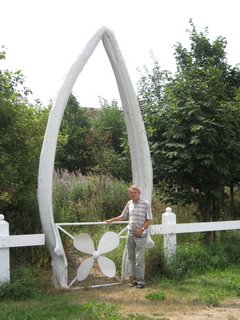 Ian at the gate to the Feddersen's house
Ian at the gate to the Feddersen's houseIan explained that his mother had been at the house in the 1920s and before we knew what was happening we had been invited inside, served with glasses of redcurrant juice and made welcome by a lady who spoke excellent English. This was Frau Margret Feddersen, the widow of the painter's grandson, whose sister Ian's mum had looked after. Curiously, Frau Feddersen had worked in the school in Niebüll teaching English and had actually met Ian at that time when he sat in on her lessons. Ian remembered her, but not surprisingly, she could not recall him. However, there were many threads, and links that over the next couple of hours where drawn together and both Ian and Frau Feddersen obviously got great pleasure recalling the past and filling in gaps in the history of events in the lives of those in both families. She was also able to tell Ian what happened to various children he had known in the town 45 years ago who had been her pupils.
 Feddersen's farmhouse, near Maasbüll
Feddersen's farmhouse, near MaasbüllWe sat, surrounded by memorabilia of the artist, including a portrait of his daughter Lolle as a young girl. Later in life it was she who invited Ian's mother to stay with the family to help her with the children. There were also examples of landscape paintings of this area with its wild, desolate expanses, clear light and wide impressive skyscapes. When we eventually left, Frau Feddersen gave us a copy of a publication about the artist with several beautiful reproductions of his paintings, based on a doctoral thesis by Dorothee Bieske, now a curator of the museum at Flensburg.
In the garden she showed us the artist's studio, still there but unused. She explained that the whale's jawbone at the gate had been brought back from Greenland by her husband, the artist's grandson, who was once a mariner and had acquired it, along with a vicious looking rusting harpoon, from a whaling friend when he died.
Frau Feddersen spoke almost entirely in English, very coherently and with astonishing clarity of thought as she recalled all the different threads of the family's history. This was all the more surprising in that she had been considerably younger than her husband and had entered the family after Ian's mother's contact with the farm had ended. We feel we have been very privileged to have been made so welcome by such a charming, friendly and well informed lady who gave us her time so willingly and without being forewarned of our visit. Ian's mum would have been very touched to know about our meeting this afternoon and what happened to so many of the people who had been so important in her life over so many years.
We have been rather thoughtful for the rest of today. Once we left the farmhouse we returned to the campsite and took our bikes out for a ride in the countryside, visiting the pretty local village with its brick church hiding from the winds of the North Sea behind the high dyke, grazed by countless sheep. We are finding this a very interesting countryside with its own charm, despite its initial apparent emptiness and can appreciate the fascination it held for this gifted painter.
 Sheep grazing on the steep landward side of the dyke near Dagebüll
Sheep grazing on the steep landward side of the dyke near Dagebüll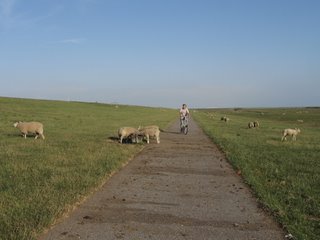 Cycling near Dagebüll
Cycling near DagebüllSunday 30th July 2006, Dagebüll, on the North Sea, Schleswig-Holstein
Today we did manage to travel out on the ferry to Föhr with our bikes and we have spent a really lovely day. This evening though we are quite exhausted, mainly because the weather has turned hot, close and humid again.
The crossing on the ferry takes about 45 minutes. It doesn't look particularly far, showing just as a very low line of yellow sand on the horizon. The water though is so shallow that the ferry cannot simply sail across but has to follow a circuitous route that has been dredged out for it between maker buoys and silver birch trees! It looked most odd seeing the slender white trunks of these leafless birches sticking up out of the sea. There are several ferries running a non-stop service with a fast turn-around at either end. Cars, bikes and passengers are carried, most vehicles having several bikes on the roof or fixed to the back. On the island there are traffic jams of bikes! Apart from those going over on the ferry they can be hired on arrival. Cars are not greatly in evidence but there is a very heavily used network of cycle paths throughout the island, which is about the same size as Jersey, but considerably flatter! We've made the comment before that Ian always heads straight for the highest hill around when we reach a new area. The highest point on Föhr is only nine metres above sea level so we were easily able to manage that.
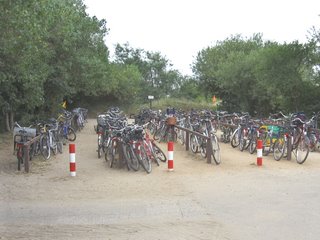 Bicycle park at the beach, near Nieblum, Föhr
Bicycle park at the beach, near Nieblum, FöhrBikes around here are enormous! Real stallions of the road with huge wheels and high handlebars. They cruise casually along sniggering to themselves as they pass Hinge and Bracket with our feet whirring on the pedals and their wheels no more than a blur as they struggle to cover the same distance! It's so flat that nobody need any gears here either on the island or the mainland. While these huge Friesian beasts treat our treasured team members with contempt, their owners gaze in astonishment, fascinated that anything so small can exist, let alone fold up small enough to fit into a bag. It's rather the same story as we have with motor homes and their owners when they see Modestine. (Legoland isn't too far away once we are over the border into Denmark. That's how people seem to think of us here with our miniature vehicles.)
The sea between Föhr and the mainland cannot be more than a few feet deep on either side of the ferry channel. Yellow sandbanks crowded with wading sea birds can be seen showing above the water. All around us sky and sea meet, each a reflection of the other, surrounding us entirely in a multi-shaded aura of blue, from the shimmering iridescent azure of the shallow waters, through the darker blue-green tones of the channel, both flecked with white from the tiny sparkling waves. Above are the paler blues and dove greys of the clouds and sky. There is nothing but a thin line on the horizon ahead that is Föhr and another behind that is the mainland at Dagebüll.
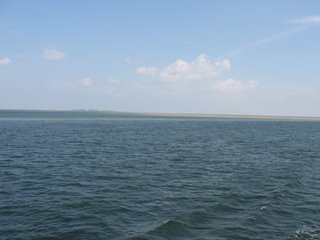 Approaching Föhr
Approaching FöhrOn arrival we first explored the main town of Wyk. Actually it's the only one though there are several very pretty villages, some of which we later visited. The town was crowded with happy holiday-makers and the cycle parks packed solid. Away from the harbour breeze it was very hot and close. Above the beach there were countless little cafes and the sandy beaches were covered in brightly coloured basket seats, small children and sandcastles.
 Bathing machine and bathing beauty, Wyk, Föhr
Bathing machine and bathing beauty, Wyk, Föhr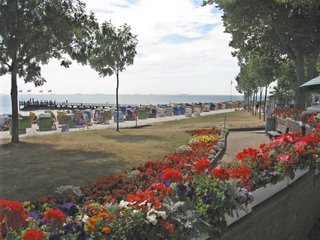 Sea front at Wyk, Föhr
Sea front at Wyk, FöhrThere was a Sunday market on the jetty and we joined the crowds for a Stehcafé lunch at one of the mobile canteens selling jacket potatoes filled with crab meat and shrimps with garlic mayonnaise. Other diners were enjoying rollmops, smoked fish sandwiches fried fish and even Kartoffelpuffer (battered potato cakes) with apple purée.
 Lunch – shrimps, not worms! Wyk, Föhr
Lunch – shrimps, not worms! Wyk, FöhrWe have only cycled part of the island. It really has been too hot and close to do more. We were surprised to find how much of an effort it was to force ourselves out into the countryside and head off through some of the pretty villages of reed–thatched cottages with their very beautifully decorated front doors and enclosed gardens bright with climbing roses and hydrangeas.
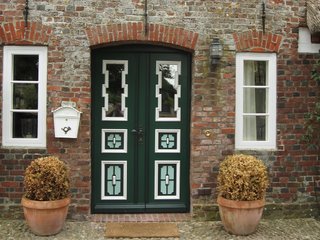 Typical doorway, Nieblum, Föhr
Typical doorway, Nieblum, FöhrAt Nieblum we parked and explored the village on foot, including the very attractive church yard surrounded by fields of stubble where the harvest had recently been gathered in. This really is a picturesque little village of 19th century cottages. We stopped in the garden of one where refreshments were being served under shady umbrellas. Here we had a couple of coffees to wake ourselves up and Ian managed to find room after his lunch for warm cherry cake and whipped cream. After that he had to struggle to build up enthusiasm to continue our round route back to Wyk along the quiet rural byways where the main traffic was bicycles. On the way we stopped beside a windmill to watch a gymkhana. The chief event seemed to be dads downing litres in the beer tent. Out in the field there were dozens of Brigittes and Brunhildas cantering their ponies around the field but not doing a great deal else.
 Village church, Nieblum, Föhr
Village church, Nieblum, Föhr Churchyard, Nieblum, Föhr
Churchyard, Nieblum, Föhr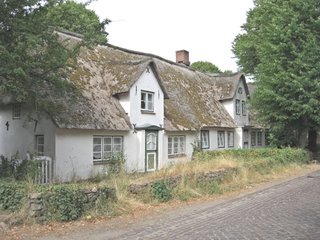 Cottages, Nieblum, Föhr
Cottages, Nieblum, Föhr Cottages, Nieblum, Föhr
Cottages, Nieblum, Föhr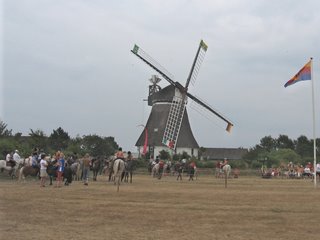 Gymkahna, Wrixum, Föhr
Gymkahna, Wrixum, FöhrLater, back in Wyk, we took Hinge and Bracket for a quick circuit around the Berliner Ring, just to restore their self esteem after being laughed at and looked down upon during the afternoon. Normally this is Berlin's equivalent of London's M25 but Wyk has its very own version, covering about a kilometre around a very pleasant quiet residential area! After that final exertion we sat by the beach licking ices until it was time to catch the ferry back across the sea. On deck it was still very hot and the air hardly moved during the crossing. We dozed most of the way.
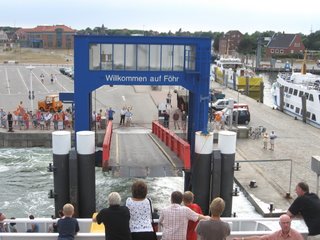 Ferry returning from Wyk, Föhr
Ferry returning from Wyk, FöhrThere is something rather exciting about seeing a crowd on the quay watching the ferry arrive from an off-shore island, frequently bringing friends and family together. Knowing how far we are from our real home, there was a rather nice feeling cycling off the ferry this evening on our little bikes, and making our way through the streets of Dagebüll back to Modestine in the middle of her field. Ian stopped at the café by the campsite entrance and bought a pile of chips and soon we were enjoying them with home-made fish cakes from yesterday's market in Niebüll and lots of salad, together with the rest of last night's wine.
This evening, as we write this, it is becoming apparent why we felt so drained on the island. Thunder is rumbling loudly around the skies, lightening is flickering out at sea and there are even a few heavy drops of rain. We've been standing outside hopefully to welcome him back like the prodigal son, but he's still reluctant to return.
